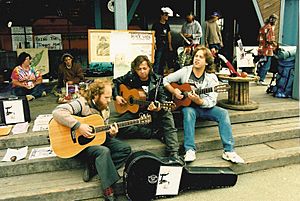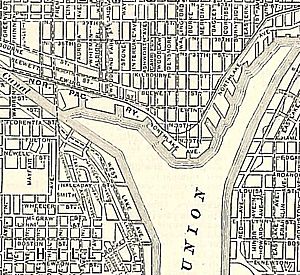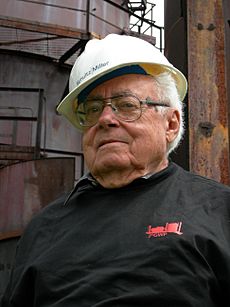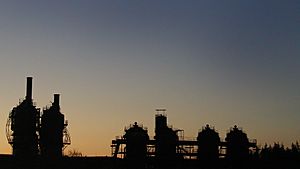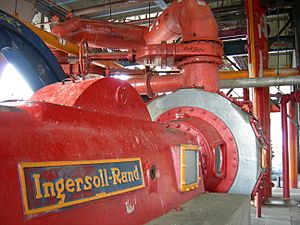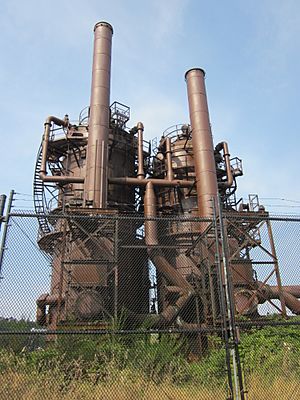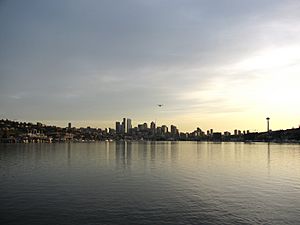Gas Works Park facts for kids
Quick facts for kids |
|
|
Gas Works Park
|
|
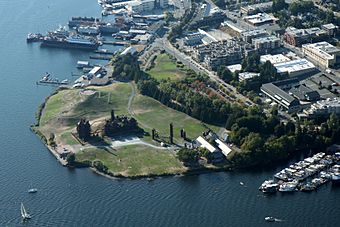
The park seen in 2011
|
|
| Lua error in Module:Location_map at line 420: attempt to index field 'wikibase' (a nil value). | |
| Location | 2000 N. Northlake Way, Seattle, Washington, U.S. |
|---|---|
| Area | 20.5 acres (8.3 ha) |
| Built | 1975 |
| Architect | Haag, Richard Haag; Jefferies-Norton Corp |
| Architectural style | Post-industrial |
| NRHP reference No. | 02000862 |
| Added to NRHP | January 2, 2013 |
Gas Works Park is a special park in Seattle, Washington, USA. It covers about 19.1-acre (77,000 m2) of land. This park was once a big factory called the Seattle Gas Light Company. It made gas for homes and businesses.
The park is on the north shore of Lake Union. It is at the south end of the Wallingford neighborhood. On January 2, 2013, Gas Works Park was added to the National Register of Historic Places. This means it is a very important historical site.
Gas Works Park is unique because it still has parts of the old gas factory. This factory made gas from coal. It was the only one of its kind left in the United States. The factory worked from 1906 to 1956. The city of Seattle bought the land in 1962 to turn it into a park. The park first opened to the public in 1975.
A famous landscape architect named Richard Haag designed the park. He won a special award for his amazing design. The park was first going to be named after Myrtle Edwards. She was a city councilwoman who helped get the land. But her family asked for her name to be removed. This was because the park design kept parts of the old factory. Another park was later named Myrtle Edwards Park.
Contents
Discovering Gas Works Park
Gas Works Park uses many parts of the old factory. Some parts are left as ruins. Others have been fixed up and painted. They are now part of a fun "play barn" for kids. This play barn was built using parts of the factory's old compressor building. Many people think Gas Works Park is one of the most unusual parks in the world.
The park also has a special hill for flying kites. At the top of the hill, there is a cool sundial. For many years, the park hosted "Peace Concerts" in the summer. Now, these concerts happen in different Seattle parks. Gas Works Park is also famous for its Independence Day fireworks show. It is a popular place for the Solstice Cyclists to finish their ride.
The park was once the start of the Burke–Gilman Trail. This trail follows an old railway line. Now, the trail goes much further northwest. It passes through the Fremont neighborhood and towards Ballard.
When the factory was running, the soil and water became dirty. Park designers worked to clean the area using natural methods. Today, there are no known dirty spots on the surface. But sometimes, a sticky substance called tar still comes out. When this happens, it is quickly cleaned up.
Even though it's a bit hidden, the park has been a place for many public gatherings. People often meet there for important events.
Gas Works Park has even been in movies! You might have seen it in Singles or 10 Things I Hate About You. It was also featured twice on the TV show The Amazing Race. It was the finish line for Season 3 and the starting line for Season 10. The park was also the site of the 2021 NHL Expansion Draft for the Seattle Kraken hockey team.
The buildings in the park are important city and state landmarks.
Park History and Development
Gas Works Park sits on a piece of land that sticks out into Lake Union. This land is about 20.5 acres (8.3 hectares) big. Not much is known about the area before Europeans arrived. But Native American groups did live around Lake Union. In the mid-1800s, Thomas Mercer named it "Lake Union." He hoped canals would connect it to Puget Sound and Lake Washington.
By the 1850s, sawmills were built around Lake Union. They used the many trees in the area. In the 1880s, more industries came. These included brick making, shipbuilding, and iron works. Small canals were dug in 1885. These helped move logs, but not big ships. When the Seattle, Lake Shore and Eastern Railway arrived in 1887, Lake Union became an important industrial area.
In 1900, the Seattle Gas Light Company started buying land here. Their coal gas factory began working in 1906. At that time, the neighborhood was called Edgewater. Even though the gas company was buying land, experts suggested in 1903 that this spot should be a park. They thought it would be great for views and boating.
In 1911, a city plan suggested Lake Union should be an industrial area. The plan said it would be important for Seattle's business. The Lake Washington Ship Canal and Ballard Locks were finished in 1917. This helped shipping and shipbuilding grow on Lake Union.
The gas factory on Lake Union was a very large private utility. It was called "Seattle Lighting Company" until 1930. Then, its name changed to "Seattle Gas Company." It mainly made gas from coal for lighting homes. Later, this gas was also used for cooking, heating, and refrigeration.
In 1937, the factory switched from coal to oil because coal was too expensive. New machines were built to make gas from oil. By 1947, more oil-to-gas machines were added. The factory also made other products. These included charcoal briquets, toluene, and sulfur.
The factory had many buildings. These included storage tanks, a boiler house, and offices. It also had shops for electrical work, carpentry, and welding. An old railroad track ran through the north part of the site.
By 1954, the factory used 1,071 miles (1,724 km) of gas pipes. It served Seattle and nearby towns like Renton and Kent. The factory stopped making gas in 1956. This was because Seattle switched to natural gas.
Even though gas production stopped in 1956, the factory buildings were still there in 1962. That year, the city of Seattle started buying the old factory land. The city paid $1.34 million for it. Gas Works Park officially opened to the public in 1975.
Park Design and Cleanup Efforts
When the city bought the land, people debated what to do with it. Some wanted to build new things. But others, led by Myrtle Edwards, wanted a park. In 1970, Richard Haag Associates (RHA) was hired to plan the new park. Richard Haag realized the site was special. It was the last gas factory of its kind. He suggested keeping parts of the factory. He saw their "historic, esthetic and utilitarian value."
Haag's plan was approved in 1971. It focused on reusing the old buildings and machines. It also aimed to clean the soil and water using natural methods. This way, the park would show Seattle's industrial past.
In 2022, the Washington State Department of Ecology announced plans for more cleanup. This final cleanup will cover about 50.0-acre (20.2 ha) around the park. It is set to start in 2027. The goal is to remove substances like arsenic and nickel. If successful, people might be able to use the waters of Lake Union from the park. This cleanup project is estimated to cost $73 million.
Meet the Park's Architect
Gas Works Park was designed by Richard Haag. He is a very well-known landscape architect from Seattle. Haag is the only person to win the American Society of Landscape Architects Award for design excellence twice. One of these awards was for his work on Gas Works Park. His design for the park has been praised all over the world.
Exploring the Park's Features
The park covers about 20.5 acres (83,000 m2) of land. It sticks out 400 feet (120 m) into Lake Union. The park has 1,900 feet (580 m) of shoreline. To the north is the Wallingford neighborhood. The area around the park used to be very industrial. But now, more shops and businesses are moving in.
You can enter the park through a parking area. Or you can use the Burke-Gilman Trail. This path is for bikes and walking. It connects Puget Sound to Lake Washington.
The park has seven main areas:
- The Earth Mound
- North Lawn
- Towers
- Prow
- Picnic Lawn and Shelter
- Play Barn
- South Lawn
The Earth Mound, Prow, and Lawns are open spaces. They are great for relaxing or playing. They also offer amazing views. The Towers, Play Barn, and Picnic Shelter are parts of the original factory. They have been changed for park use.
Gas Works Park was designed to be a busy urban park. It uses its unique structures in fun ways. It offers a different kind of park experience. Hundreds of thousands of people visit Gas Works Park every year. They come for the Independence Day fireworks. They also come for concerts, kite-flying, jogging, and public meetings. The open space and views make it a popular spot.
However, you cannot go into Lake Union from the park. The lake's bottom still has some harmful substances. So, activities like swimming, boating, fishing, and wading are not allowed.
The Great Mound
The "Great Mound" is a big hill in the park. It was made from thousands of cubic yards of old building rubble. This rubble was covered with fresh soil. At the top of the mound, there is a special sundial. Two local artists, Chuck Greening and Kim Lazare, created it. The sundial is made of concrete. It has rocks, shells, glass, and bronze. You can tell the time and season by using your own shadow on the sundial.
Green Lawn Areas
The park has several large lawn areas. The soil here was cleaned using a special process. It involved mixing sewage sludge and sawdust into the ground. This helped clean the soil. It also allowed grass to grow well. This means the lawns can handle a lot of use with little upkeep.
The Impressive Towers
You will see two groups of towers in the park. The first group has six tall towers. These were used to make gas. The second group includes an oil absorber and an oil cooler. These are located between the play barn and the gas generators. The gas generators worked in pairs. They were built at different times.
- Towers 1 and 2: These are the largest towers. They are closest to the lake. They were built in 1937–38. Tower 1 is about 80 ft (24 m) tall. Tower 2 is about 75 ft (23 m) tall. At their busiest, they could make 6 million cubic feet (170,000 m3) of gas each day.
- Towers 3, 4, 5, and 6: These four towers were built in 1947. They are smaller than Towers 1 and 2. Each is about 50 feet (15 m) tall.
Between the generators and the play barn, you will see the oil absorber (80 ft (24 m) tall) and the cooler (40 ft (12 m) tall). These towers helped separate different oils from the gas. These oils were then used to make other products.
The Prow Platform
This concrete platform was built in 1936. It was used to unload coal from ships. Now, it is part of the park. Handrails have been added along the lakeside edges for safety.
Play Barn and Picnic Shelter
The buildings for the play barn and picnic shelter are very old. They date back to the original gas factory around 1910. They were built mostly from wood. The pump house, now the play barn, is about 7,340 sq ft (682 m2). The boiler house, now the picnic shelter, is about 5,720 sq ft (531 m2). Their wooden frames are still strong and stand on concrete foundations.
The boiler house used to have two large boilers. One made steam for the gas-making process. The other made steam for the engines in the pump house. You can still see the tubes from one boiler inside the picnic shelter. It's a cool look at old factory technology.
The pump house is now the fun play barn. Many of the original pumps, compressors, and pipes are still inside. A huge 3,000 hp (2,200 kW) compressor with a 10 short tons (9.1 t) flywheel ran all the time. It kept the factory working 24 hours a day. In this building, air was compressed for making gas. The finished gas was then sent to storage or out to customers.
Outside the play barn, there is a refurbished smoke arrestor hood. It was designed in 1935 to reduce pollution. Now, it's a fun structure for climbing!
Concrete train trestles are also part of the park's entrance. These were from the original 1906 factory. They show where train tracks ended. Coal cars would ride up these trestles and drop coal into hoppers below.
Why Gas Works Park is Important
The old factory structures are like a museum of industrial history. They are the last examples of this type of technology. These structures have been saved and are part of the park's design. A writer for New York Times said that Gas Works Park is one of the most advanced urban landscape designs. He called the towers, tanks, and pipes a "powerful industrial still life." He said they are a monument to the city's industrial past. The park shows a big change in how we see old industrial sites. Now, they are seen as ways to make cities better.
Experts recognized the park's importance early on. In 1971, someone from the National Park Service said Gas Works Park would be unique. They believed it would set an important example for saving industrial buildings. This would be done by finding new, creative uses for them.
Not all the old buildings were saved. But the most important towers remain. The pump house and boiler house were reused. This kept their structure and much of the old machinery. The park still has its original boundaries and lake frontage.
The Seattle Gas Company's factory, now Gas Works Park, was started by Arthur A. Denny. He was one of Seattle's first important pioneers. For the first half of the 1900s, the Gas Company helped Seattle grow a lot. Besides making gas for energy, the factory also made other important products. These included tar for roofs, lampblack for ink, and charcoal briquets for heating. It also made sulfur for bug sprays and toluene. Toluene was very important during World War II for making explosives like TNT. So, the gas works helped both daily life in Seattle and the country's war efforts.
The structures and machines in Gas Works Park today are reminders of the Industrial Revolution. This was a time when factories changed the world. Gas Works Park is the only old gas factory from that time in the United States that is saved as a public park. It is the only site with most of its gas-making equipment still there.
During its time, this factory was one of about 1400 similar plants in the U.S. Even though these towers and machines are no longer used, they show how clever people were. They are a visual reminder of old technology. As a professor from the University of Washington said, "History sits on this little wasteland." He meant it tells the story of Seattle and the world.
Gas Works Park has also influenced how people think about cleaning up old industrial sites. It is seen as a great example for converting industrial areas. It is studied and mentioned in textbooks. Since it opened, Gas Works Park has won many awards for its design and new ideas. One award jury said it was "a remarkably original and attractive example of how to reclaim a seemingly hopeless and obsolete industrial installation." They called it "A project of historical significance for the community. A symbol of American technology preserved."
One writer described the park's towers as "black shapes... that might be the pictogram for the works of industrial man."



